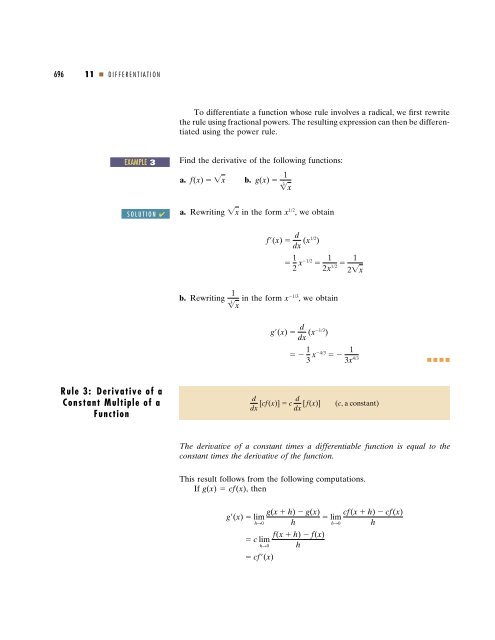11DIFFERENTIATION - Department of Mathematics
11DIFFERENTIATION - Department of Mathematics
11DIFFERENTIATION - Department of Mathematics
Create successful ePaper yourself
Turn your PDF publications into a flip-book with our unique Google optimized e-Paper software.
696 11 DIFFERENTIATION<br />
EXAMPLE 3<br />
SOLUTION ✔<br />
Rule 3: Derivative <strong>of</strong> a<br />
Constant Multiple <strong>of</strong> a<br />
Function<br />
To differentiate a function whose rule involves a radical, we first rewrite<br />
the rule using fractional powers. The resulting expression can then be differentiated<br />
using the power rule.<br />
Find the derivative <strong>of</strong> the following functions:<br />
a. f(x) x b. g(x) 1<br />
3 x<br />
a. Rewriting x in the form x 1/2 , we obtain<br />
b. Rewriting 1<br />
f(x) d<br />
dx (x1/2 )<br />
1<br />
2 x1/2 1 1<br />
1/2 2x 2x<br />
3 x in the form x1/3 , we obtain<br />
g(x) d<br />
dx (x1/3 )<br />
1<br />
3 x4/3 1<br />
3x 4/3 <br />
d<br />
d<br />
[cf(x)] c [f(x)] (c, a constant)<br />
dx dx<br />
The derivative <strong>of</strong> a constant times a differentiable function is equal to the<br />
constant times the derivative <strong>of</strong> the function.<br />
This result follows from the following computations.<br />
If g(x) cf(x), then<br />
g(x) lim<br />
h0<br />
c lim<br />
h0<br />
cf(x)<br />
g(x h) g(x)<br />
h<br />
f(x h) f(x)<br />
h<br />
cf(x h) cf(x)<br />
lim<br />
h0 h

















